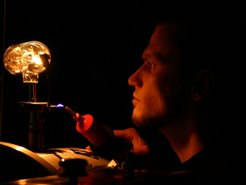So this evening after work I headed to the nearest Obi, and raided their plumbing department. One hour later and là voilá! my very own plumbing fixture lamp. Bask in it's galvanised glory!
It is of course illuminiating the "New Annotated Dracula" (see review here) as is fitting, because, ah, vampires like plumbing. Yes.
From another angle:
And finally a black-and-white close-up, in case you want to make your own:
It is really quite simple, and did not take me more than an hour. Well, it is not quite finished, since I still have to stuff the two cables into a bit of shrink-wrap or so, but it does work. In case you want to copy my design, you'll need (please excuse me if I get the terminology wrong, my knowledge of plumber-terminology is sadly lacking. Clearly, I will never get to be a vampire.):
- 5 "elbow" pieces for the legs and head
- 5 T-pieces
- 6 short male-male connectors, 4cm long
- 1 male-male connector, 8 cm long
- 1 female-female connector
- 1 longer male-male pipe
- one 40 mm to 12 mm reduction (the head)
- a 40 mm diameter (GU 4), 12V, 20 Watt halogen bulb
- a 12 Volt transformer capable of delivering 20 Watt
- a bit of wire
- a bit of super glue (cyan acrylate)
Assemble the lamp and don't forget to insert the wire into the tubes. solder the leads to the bulb and insert it into the lamp-head - glue it in with a bit of super-glue. Don't use hot glue, since the head will get quite hot. Aaand... that's it. You are now the proud owner of a plumbing fixture lamp. Do keep an eye out for jealous vampires!
A few modifications could be made to the design: Using leds instead of halogen bulbs would decrease the energy consumption by about a factor of five, while keeping the temperature of the lamp-head down. I actually thought about doing that, but being a victim of the evil, evil instant-gratification society that formed me, I wanted my lamp now, now, now!, and using halogen saved me at least 10 minutes of soldering. There might actually led-replacement lamps for the halogen standard GU 4 - I know this stuff exists for GU 5.3, since I use it for my bicycle lights. But the good old Obi didn't have them and... now, now, now!
So, tell me what you think: Fugly? Awesome? Will you make your own?





Fabulous!
ReplyDeleteWon't make my own - yet. No space fo either soldering station nor new lamp ;O)
Male to male connectors are called nipples and female to female are couplings.
ReplyDeleteThanks! Now I am a bit closer to being a plumbing expert and thus prospective vampire material!
ReplyDeleteI love it, but I already have like dozens of lamps (and a good supply of LED lamps), in case I can't help myself.
ReplyDeleteI hear you - I am a bit of a light-junkie (especially in winter!), so I have quite a few of them myself. But this was so much fun to build that I am contemplating building a few more to give to friends and family ('cause they have to pretend to like it!) - maybe I can figure out a nice water-tap switch like the original designer...
ReplyDeleteThe lamp is really fantastic.If you love some elegant and unique lamps for your study room catch more stuff at:
ReplyDeletehttp://studylite.in/index.php?option=com_virtuemart&Itemid=19&cid=cm
Thanks ashwini, and thanks for the link, they really have nice lamps. Maybe I can steal some ideas...
ReplyDeleteI love these lamps..They are an added advantage to your room..
ReplyDeletecheck more stuff at:
http://studylite.in/index.php?option=com_virtuemart&Itemid=19&cid=cm
Love the lamp! I'm making my own, but running into some trouble.
ReplyDeleteHow did you screw the base together? Specifically the 5 Tees, 5 short male-male connectors (4cm long), 1 male-male connector (8cm long), and 1 female-female connector?
Whenever I do it, and get to the last pipe, while I screw one end in the other end unscrews?
Hopefully the solution is super simple and I'm just over looking it.
Thanks in advance!
Hey Anonymous,
ReplyDeleteI ran into the exact same problem, and solved it by cheating: If you look closely at the photo, you'll see that there are two female conectors touching each other - they actually have no male connector between them.
In the end, a rectangular base is not optimal - I built another lamp with a triangular base, wich is much easier to do! you can see it here
Hope this helps,
Boris